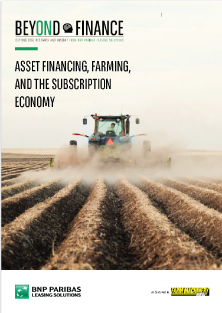By Tristan Watkins, CEO, BNP Paribas Leasing Solutions
Farming professionals are cautious about capital expenditure out of sheer necessity: a single tractor can cost tens of thousands of pounds, and it’s often a narrow-margin industry. The younger generation, however – raised on the subscription payment model used by companies such as Netflix and Spotify – is well aware that there are viable alternatives to an outright purchase.
In an age of belt-tightening and satellite precision farming, many are taking the subscription economy very seriously. In America, companies like FarmLink facilitate the rental and transport of equipment across hundreds of miles: as one peak harvest ends, another begins. There has been a wider shift in attitudes and expectations: farmers want machines that move with the season: the idea of paying monthly, and for no more than you use, has become highly appealing – and there are several good reasons why.
Breaking the replacement cycle
Farming machinery has a particularly short half-life: agricultural work is conducted under conditions that cause hardy equipment to deteriorate rapidly. Accordingly, the reluctance to invest heavily in new equipment is understandable. Sooner or later, your new machine will be outdated – so why not wring as much performance out of it as you can?
A subscription model provides affordable access to the best equipment on the market by allowing farmers to pay less money over a longer period of time. Essentially, your commitment to a machine lasts for as long as that machine is useful: you’re never too far away from an equally inexpensive upgrade.
Energy efficiency
At present, farming machinery has to comply with rigorous EU energy efficiency standards – but compliance isn’t cheap, so more money has to be invested in development. This makes equipment more expensive to buy, and forces farmers to either pay more money or use less energy (which costs them more in the long run).
A subscription-based agreement allows these costs to be spread over a longer period of time: when they have low margins and a finite agreement, a slightly higher monthly payment looks more appealing than a single, significantly more expensive transaction.
A fleet for all seasons
Farming is a seasonal profession: most of the profits come at the end of summer when the harvest is sold. Accordingly, it’s necessary to spread profits over a long period of time: what you make in August may have to tide you over for an entire year.
Fluctuations in income are simply part of the trade – but they’re a part of the trade that alternative payment structures can accommodate. The terms of a subscription-based agreement can be adjusted to cover a time period that suits the farmer’s harvest. This allows them to hire the vehicle they need, when they need it in the farming cycle – instead of buying it outright and letting it lay fallow for the rest of the year.
A proactive financier will apprise a farmer of these options upon request. It’s always worth seeking independent advice from your accountant before agreeing to any funding agreement – subscription-based or otherwise. They can be long-term commitments, and you need to ensure they accommodate your requirements.
Make sure you’re being treated fairly, but don’t be discouraged: that the subscription model is gaining traction in agriculture is a positive – and long overdue – development.
Share post:
Featured in ...

Media contact
Suhale Vorajee
Head of Marketing and Communications
BNP Paribas Leasing Solutions UK
T: 01179 100 895
E: click here





